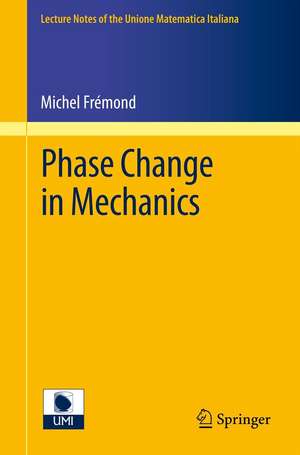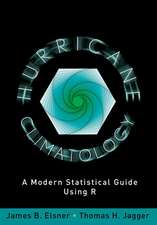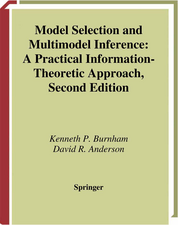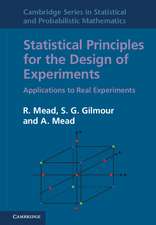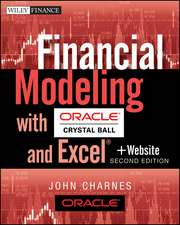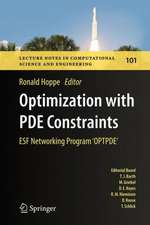Phase Change in Mechanics: Lecture Notes of the Unione Matematica Italiana, cartea 13
Autor Michel Frémonden Limba Engleză Paperback – 9 feb 2012
Din seria Lecture Notes of the Unione Matematica Italiana
-
 Preț: 281.43 lei
Preț: 281.43 lei -
 Preț: 353.79 lei
Preț: 353.79 lei -
 Preț: 418.78 lei
Preț: 418.78 lei -
 Preț: 247.82 lei
Preț: 247.82 lei -
 Preț: 346.59 lei
Preț: 346.59 lei -
 Preț: 356.08 lei
Preț: 356.08 lei - 15%
 Preț: 704.36 lei
Preț: 704.36 lei -
 Preț: 451.48 lei
Preț: 451.48 lei -
 Preț: 347.04 lei
Preț: 347.04 lei - 15%
 Preț: 525.66 lei
Preț: 525.66 lei -
 Preț: 512.27 lei
Preț: 512.27 lei -
 Preț: 390.25 lei
Preț: 390.25 lei -
 Preț: 480.62 lei
Preț: 480.62 lei - 15%
 Preț: 468.90 lei
Preț: 468.90 lei -
 Preț: 416.54 lei
Preț: 416.54 lei -
 Preț: 344.36 lei
Preț: 344.36 lei -
 Preț: 353.99 lei
Preț: 353.99 lei -
 Preț: 448.21 lei
Preț: 448.21 lei - 15%
 Preț: 584.58 lei
Preț: 584.58 lei - 15%
 Preț: 493.89 lei
Preț: 493.89 lei - 15%
 Preț: 582.95 lei
Preț: 582.95 lei -
 Preț: 350.04 lei
Preț: 350.04 lei -
 Preț: 346.97 lei
Preț: 346.97 lei -
 Preț: 390.63 lei
Preț: 390.63 lei - 15%
 Preț: 650.19 lei
Preț: 650.19 lei -
 Preț: 348.35 lei
Preț: 348.35 lei -
 Preț: 344.47 lei
Preț: 344.47 lei
Preț: 389.70 lei
Nou
Puncte Express: 585
Preț estimativ în valută:
74.59€ • 77.57$ • 62.41£
74.59€ • 77.57$ • 62.41£
Carte tipărită la comandă
Livrare economică 14-28 martie
Preluare comenzi: 021 569.72.76
Specificații
ISBN-13: 9783642246081
ISBN-10: 3642246087
Pagini: 316
Ilustrații: XIII, 303 p. 66 illus., 36 illus. in color.
Dimensiuni: 155 x 235 x 25 mm
Greutate: 0.45 kg
Ediția:2012
Editura: Springer Berlin, Heidelberg
Colecția Springer
Seria Lecture Notes of the Unione Matematica Italiana
Locul publicării:Berlin, Heidelberg, Germany
ISBN-10: 3642246087
Pagini: 316
Ilustrații: XIII, 303 p. 66 illus., 36 illus. in color.
Dimensiuni: 155 x 235 x 25 mm
Greutate: 0.45 kg
Ediția:2012
Editura: Springer Berlin, Heidelberg
Colecția Springer
Seria Lecture Notes of the Unione Matematica Italiana
Locul publicării:Berlin, Heidelberg, Germany
Public țintă
ResearchCuprins
1 Introduction.- 2 The State Quantities and the Quantities Describing the Evolution.- 3 The Basic Laws of Mechanics.- 4 Solid-liquid Phase Change.- 5 Shape Memory Alloys.- 6 Damage.- 7 Contact with Adhesion.- 8 Damage of Solids Glued on One Another. Coupling of Volume and Surface Damages.- 9 Phase Change with Discontinuity of Temperature: Warm Water in Contact with Cold Ice.- 10 Phase Change and Collisions.- 11 Collisions of Deformable Bodies and Phase Change.- 12 Phase Change Depending on a State Quantity: Liquid-vapor Phase Change.- 13 Clouds: Mixture of Air, Vapor and Liquid Water.- 14 Conclusion.
Recenzii
From the reviews:
“These lecture notes present some predictive theories of phenomena involving phase changes with applications in engineering, within the framework of continuum thermo-mechanics. The author investigates some solid-liquid phase changes, volume and surface damage, and phase changes involving temperature discontinuities. … this is a valuable contribution to the phase change theory in continuum mechanics, excluding polar and non-local constitutive behaviour, and it is recommendable to engineers and researchers interested in the field.” (M. Cengiz Dökmeci, Zentralblatt MATH, Vol. 1253, 2013)
“These lecture notes present some predictive theories of phenomena involving phase changes with applications in engineering, within the framework of continuum thermo-mechanics. The author investigates some solid-liquid phase changes, volume and surface damage, and phase changes involving temperature discontinuities. … this is a valuable contribution to the phase change theory in continuum mechanics, excluding polar and non-local constitutive behaviour, and it is recommendable to engineers and researchers interested in the field.” (M. Cengiz Dökmeci, Zentralblatt MATH, Vol. 1253, 2013)
Textul de pe ultima copertă
Predictive theories of phenomena involving phase change with applications in engineering are investigated in this volume, e.g. solid-liquid phase change, volume and surface damage, and phase change involving temperature discontinuities. Many other phase change phenomena such as solid-solid phase change in shape memory alloys and vapor-liquid phase change are also explored. Modeling is based on continuum thermo-mechanics. This involves a renewed principle of virtual power introducing the power of the microscopic motions responsible for phase change. This improvement yields a new equation of motion related to microscopic motions, beyond the classical equation of motion for macroscopic motions. The new theory sensibly improves the phase change modeling. For example, when warm rain falls on frozen soil, the dangerous black ice phenomenon can be comprehensively predicted. In addition, novel equations predict the evolution of clouds, which are themselves a mixture of air, liquid water and vapor.
Caracteristici
Thermomechanical predictive theories of phase change are improved by a renewed principle of virtual power Coupling of volume damage and of surface adhesion are highly innovative for civil and mechanical engineering A novel theory of macroscopic clouds evolution innovates in fluid mechanics Mechanical and thermal effects of collisions, involving phase change are accurately and comprehensively predicted Includes supplementary material: sn.pub/extras
